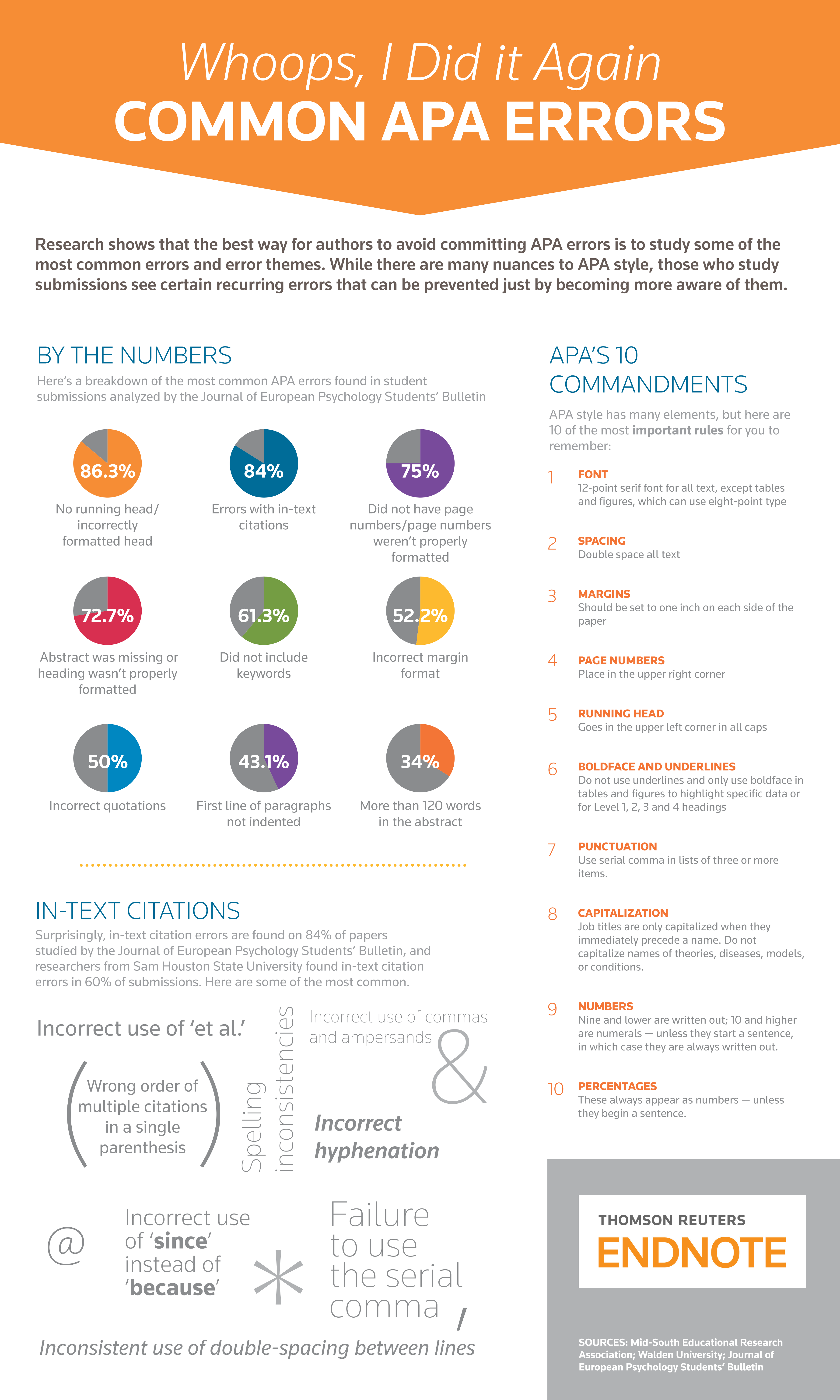As a psychology student who uses APA style in almost every assignment, it would be easy to think that I understand every APA style rule and follow them to the letter at all times. However, that is not true for me, or for many students who use APA style.
In fact, a study was conducted by the Journal of European Psychology Students (JEPS) in 2013. which looked at the most common mistakes individuals made when submitting a manuscript to them for publication. From this study, JEPS has identified the top 10 most common APA style errors made, and has even translated it into this wonderful infographic.

This blog will only be discussing five of these errors that JEPS has found, since some of these errors do not apply to most college students writing a term paper (such as abstracts).
1. In-text citations
As the infographic shows, Eighty-four percent of all papers looked at in this study had problems with in-text citations. What they mean by problems with in text citations is this:
- Incorrect use of ampersands
When citing a work with multiple authors, writers sometimes use the word ‘and’ instead of using the ampersand ‘&’. This might seem like a small error, but it is something that some teachers highly frown upon, and something that is definitely not allowed when submitting to journals.
Incorrect: (Smith and Johnson, 2012)
Correct: (Smith & Johnson, 2012)
- Spelling inconsistencies
It is very common for students to misspell an author’s name in a works cited, especially when there are multiple authors or there are longer names.
Incorrect: (Johnson, Steve, Mark, Alyl et al., 2015)
Correct: (Johnson, Steve, Mark, Ally et al., 2015)
A great way to stop this from happening is to use the Manage References feature of Microsoft Word. This allows you to enter all of your references into Word and then be able to paste the in-text citation in where needed. It is also just a great feature that can be used for any reference paper!
- Wrong order of multiple citations in one sentence
This is a very common mistake that people make just because it is a very rare situation and it is not something that is normally taught in classes. When there is more than one reference used in a single sentence they should be listed in alphabetical order in the in-text citation, not by the order that they are referenced to in the sentence. Each citation should be separated by a semi-colon, but still contained within one parenthesis.
Incorrect: (Shrouder, 2015; Abde, 2013; Leila, 2008)
(Shrouder, 2015) (Leila, 2008) (Adbe, 2013)
Correct: (Abde, 2013; Leila, 2008; Shrouder, 2015)
2. Citations in text not matching citations under reference
This error can occur in one of two ways: there are references used in the paper that are not included on the reference list, or there are references on the reference list that are never cited within the paper.
For some writers, this concept is a bit confusing since other style guides allow you to list all works that were consulted during the process, but that you may not directly cite within the paper. This is not the case with APA. If you cite something in a paper then it must by included in the reference list. And if something is on your reference list, it must be cited in the paper.
A great way to stop this mistake from happening is to double-check your paper and your reference page before submission. You can go through your paper and list all of the works that are included within in-text citations (including years!***). Then, all you need to do is double-check that list with the list of citations on the reference page.
Now this mistake might happen because you listed the wrong year for your in-text citation, or maybe you forgot to add that in-text citation for that one source. So pay special attention to this process and make sure you have cited everything that you took from a separate source.
**Note: This mistake commonly happens when working with an author that has published in multiple years, so make sure you pay special attention to these instances**
3. Not correctly citing works with multiple authors
During this research, JEPS found that 90.9% of all authors made three or more mistakes when formatting their references. This might be a very overwhelming number, but this is the easiest mistake to turn around.
Now, most people might start to get overwhelmed when they are working with sources that have multiple authors. However, not to worry. I will break down the formatting for all types of sources so this never happens to you in the future.
- Two authors for a single source
First in-text citation: ( Author one & Author two, year)
(Smith & Curt, 2008)
Second and all other in-text citations: does not change (see above)
- Three to five authors for a single source
First in-text citation:
(Author one, Author two, Author three & Author four)
(Sun, Cornell, Petty & Wegner, 2015)
Second and all other in-text citations:
(Author one et al., year)
(Sun et al., 2015)
- Six or more authors for a single source
First in-text citation:
(Author one et al, year)
(Harris et al, 1998)
Second and all other in-text citations: do not change (see above)
4. Forgetting to include a running head or page number
During their research, JEPS found that 86.3% of all papers either did not have a running head or a running head that was formatted incorrectly. In addition, they found that 75% of all students who submitted a paper to us either did not include page numbers or, those that did, did not format them correctly.
- Running header
Running headers are a small part of any paper, but can have a large impact on the overall look and appeal of your essay. Some professors weigh formatting issues (such as this) very heavily, so it might even impact your overall grade.
But no need to sweat; like most of these errors, it is something that can be easily fixed. First, make sure that all formatting is taken care of before you start writing your paper. This will help you from forgetting about it later on, and it will make you feel like you have already done so much!
For the first page of your paper, your running header should look like this:
Running head: TITLE OF PAPER
Yes, your title does need to be in caps. I know, it seems a little odd or maybe even bad to you, but that’s just how it is.
No, it should not include your full title. Just anything before the colon. So for example, if the full title of my paper is “Elderly access to medical care: how medicare is changing the future of health” My running head would be “Running head: ELDERLY ACCESS TO MEDICAL CARE”
For the other pages of your paper, your running head should look like this:
TITLE OF PAPER
Now, the hardest part of headers for most is figuring out how to have the first page header be formatted different than the rest. This can be done on Microsoft Word under the Header and Footer options and looks like this:
Just make sure to click the ‘Different First Page’ option.
- Page Numbers
When writing a paper in APA style, page numbers are a must. In order to combat the issue of forgetting page numbers, I highly suggest that adding a page number is something that you do first to your paper, rather than later.
In terms of formatting, the page number should be right justified and be located on the top right of ALL pages of your paper (including the cover page). In addition, the header and the page number should be in same font as the rest of your paper (Times New Roman, 12 pt. font). This seems like an obvious thing, but most Word Processors will have a different font as the default for headers and footers than it will for the body of the paper, so you’ll need to change it manually.
In addition, it is important to note that whenever you select all of your text (either by highlighting or by ctrl+a) it does not select your text in the header/footer. You will have to manually click the text and change the font/size separately.
5. Numbers
There are two things that commonly happen to individuals when they are reporting numbers: writing out numbers when they should not be, and incorrectly writing percentages.
These errors are an easy fix: If a number is nine and below, than the number should be written out. If a number is 10 or over, then it will be written with numerals.
The only exception to this rule is that any percentage is always written out in numerals.
The study had four male participants.
The average score was 17.9 out of 25 points.
5.67% of all participants incorrectly answered question 4.
Hopefully you’ve found these tips helpful and can now tackle your final papers in APA style with ease. Do you have any APA rules, tips, tricks, or sources to share? Comment below!
References:
What Are The Most Common APA Style Mistakes Done By Students?
Click to access APA_checklist.pdf
Click to access ThePortableEditor042011.pdf
Discover more from UCWbLing
Subscribe to get the latest posts sent to your email.



